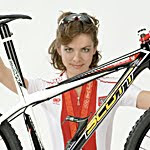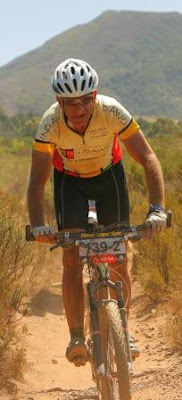
My choice of weapon for the 2011 Cape Epic was a Scott Spark RC. I purchased the bike in May 2010
(see my blog post here) and have had some wild times with it ever since. Quite simply put, its the best bike I have ever had. Here are some points from my experience with the Scott in the ABSA Cape Epic 2011.
1) Spark frame: This frame has withstood the test of time. The Peter Denk design has remained largely unchanged since its launch in about 2006 and the changes
from the 2011 model over the 2010 model are largely cosmetic. Most other companies change their frame designs on a very frequent basis. Stuff that works persist, and that's the reason the Spark is still around after so long. There have been minor changes since 2006, mostly related to increased strength and lower weight. The Spark was undoubtedly one of the most popular weapons of choice on the Epic. The proof of a frames success is how often people try and copy it. A look around the Epic Bike Park clearly indicates how many brands have copied the Spark design!
 2) Tire choice:
2) Tire choice: I tossed the stock Schwalbe Rocket Ron EVO 26 x 2.1 tires largely because I wanted to bling up my 1994 Marin Eldridge SS with them. I fitted 2.2 Continental Mountain King UST on the front and 2.2 Conti Race King UST on the rear. I initially experimented with a Race King on the front and non UST tires. On the slippery, marbled corners of Longmore, I quickly discovered that the small advantages in rolling resistance were not worth the loss of traction on the front and switched to the Mountain King. While non UST tires are lighter, I preferred the slight weight penalty and reliability of UST over non UST. Running tire pressures ranging between 1.8 and 2 bar, the tires chewed up the notoriously harsh Cape terrain without any hassles. Not a single plug, tire change, tube or patch required. I tossed a cupful of Stans in each tire and that ensured no leaks from the ever present goat head thorns in the apple orchards and vineyards of the Western Cape.
 3) Forks:
3) Forks: I used the stock DT Swiss XC100 for the Prologue and 1st Stage of the Cape Epic while my partner used the XRC100. I am a great fan of DT Swiss, but, can't say I am convinced by their forks. Perhaps its because they bought the British Pace fork company and rebranded it as DT Swiss? After 160 hours of use (service interval is 200 hours), I had to have the lock out mechanism on the fork replaced due to dirt and corrosion. Doug Patterson at DDP Tech did a great rebuild replacing the seals and lockout mechanism and the fork performed flawlessly on the prologue. However, after two hours on Stage 1, the fork started flopping around like an overcooked piece of spaghetti while my partners XRC started locking out. At Tulbagh, the SRAM tent sorted us out overnight with Rock Shox SID XX Team forks, ready for stage 2. These forks, while slightly heavier than the DT Swiss, performed flawlessly and were well worth the weight penalty. In defence of DT Swiss, it should be noted that the XC and XRC are cross country race forks and the duration of such races are 2 hours max. DT Swiss has the more robust, but heavier, XRM range designed specifically for marathons. However, the one fact that swung me in favour of Rock Shox was the availability of workshop manuals. Rock Shox provide a comprehensive manual for rebuilding the entire fork with no special tools. In contrast, it is impossible to find a rebuild manual for the DT Swiss as it must be serviced by the agent and special tools are required. I will probably never rebuild the Rock Shox myself, but, it gives great piece of mind to know the internals of your fork. The time and cost for a rebuild also weighs in Rock Shox's favour. Whereas the DT must be couriered to Joburg, the Rock Shox can be serviced locally and spares are easily available. I am still a great fan of DT Swiss as a brand, particularly of its hubs and spokes, but, I think they have some way to go to match the overall package of reliability, functionality and weight offered by Rock Shox.
4) Saddle: Saddles are highly personal choices and I switched the standard Ritchey WCS saddle to my road bike (largely for cosmetic reasons)and fitted a Fizik Gobi. This saddle, while heavier, is stunningly comfortable.
5) XX Components: I have heard various criticisms of the XX groupset. It is light, shaving 500 grams off the old XTR. XX is not for everybody. If you are even slightly over weight, you're going to be searching for a granny gear. The Avid brakes are not bombproof reliable and at the first opportunity I would switch to the new XTR's. They are difficult to service and do not have a great feel. Jan, from Kings Cycles swopped out the rear brake for a few stages and by Stage 5 SRAM had serviced the brake and thereafter it performed flawlessly, but, without the silkiness of Shimano. I have had regular issues with the BB30 bottom bracket as the bearings regularly fail and need to be replaced. I have not yet figured out what is going on here and need to invest in the bottom bracket tool and start doing this work myself.
 6) Cockpit:
6) Cockpit: I replaced the standard Ritchey 620mm WCS flat bar with the Ritchey Super Logic 660 mm rizer bar. The main reason was to ensure brake lever clearance over the top tube. I have seen far to many carbon frames trashed from a brake lever gouging the top tube due to inadequate clearance. The wider bar took a few rides to get used to, but, offers wonderful control. I like many others love the wider setup. I also fitted Ritchey WCS carbon bar ends and Serfas silicone grips which completed my cockpit setup. I am now considering a slightly longer stem and want to swop out the standard 90mm Ritchey WCS 4 Axis stem with a 130mm length.
7) Wheels: I love the stock Ritchey WCS wheels. The DT Swiss hubs are bullet proof and have a lovely resonance, while the rims have taken a pounding and are still running true and are tubeless ready. However, the use of alloy nipples is not a great idea. I weigh about 75kg and in the run up to the Epic was breaking nipples on every ride. Theuns Kotze from Cycle Service Centre rebuilt the wheels with DT revolution spokes and brass nipples, and the wheels have been running true ever since. There is a weight penalty of about 50 grams per wheel which is an acceptable trade-off for the reliability which I now have. In future, I would love to have the Ritchey Carbon wheels as I am thoroughly impressed with the reliability that Thomas Frischknecht has had from his pair.
8) Servicing: My race service was again provided by
Kings Cycles. Jan is awesome and is there at the finish everyday waiting to sort out any issues. His shop is in Worcester, South Africa's answer to Moab. Whereas Moab has slick rock, crap beer and is unrideable for half the year, Worcester has a vast network of awesome single track, great beer, wonderful wine farms and hospitable people which easily matches and surpasses Moab. At home, in Port Elizabeth, my bike was serviced by
Wayne and Roger from Wayne Pheiffer Cycles. They have provided wonderful service in both supplying and maintaining my Spark.
Brandon and Robbie at ProBike, the Scott SA distributor, have also been extremely helpful in assisting with any issues which the Pheiffer's could not sort out. My long standing wrench, Theuns Kotze, also helped with specialist work on wheel rebuilds and I regard him as an outstandingly meticulous mechanic. Unfortunately, he is heavily involved with the Yster manne's bikes, so his time is limited and he requires long lead times.
 9) Pedals:
9) Pedals: I fitted the 2011 XTR pedals for the Epic. I have never had sufficient confidence in systems such as those by Crank Brothers even though they weigh less and evidently work better. I have not had a great experience with XTR pedals and for a while used entry level Shimano pedals. The XTR pedals were great in terms of hold and feel, but difficult on entry. I was constantly lubing them to facilitate easy entry. Despite the fact that the tension was at its weakest, pedal entry remained the single most difficult thing I experienced on the Epic.
 10) Drive Chain:
10) Drive Chain: XX Clusters are notoriously expensive and the best investment one can make is a chain wear tool. Make sure you replace chains as it reaches 0.75% wear, and you can use a cluster for years. Any wear beyond that, and you will have to replace the cluster. I use SRAM PC1091 chains and have gone through three chains since May 2010 - costing approximately R1200. Others I know have used one chain and one cluster - costing approximately R3400!
11) Performance: Simply put, the Scott Spark ran like it was on rails. The handling was awesome, the Conti's providing traction on the tightest turns and holding air over the gnarliest terrain. The wide riser bars provided great control, easing fatigue over long distances. The rear suspension soaked up everything switching effortlessly between full lockout, traction control and full travel.
The nett result was a reversal of my 2010 Cape Epic. In 2010 the weapon was an aluminium framed hard tail where I weakened as the race progressed, my core being hammered into submission. The Spark of 2011 translated into a well rested core, where I felt more comfortable and stronger as the race progressed.
Awesome Scott - Thank you!
























